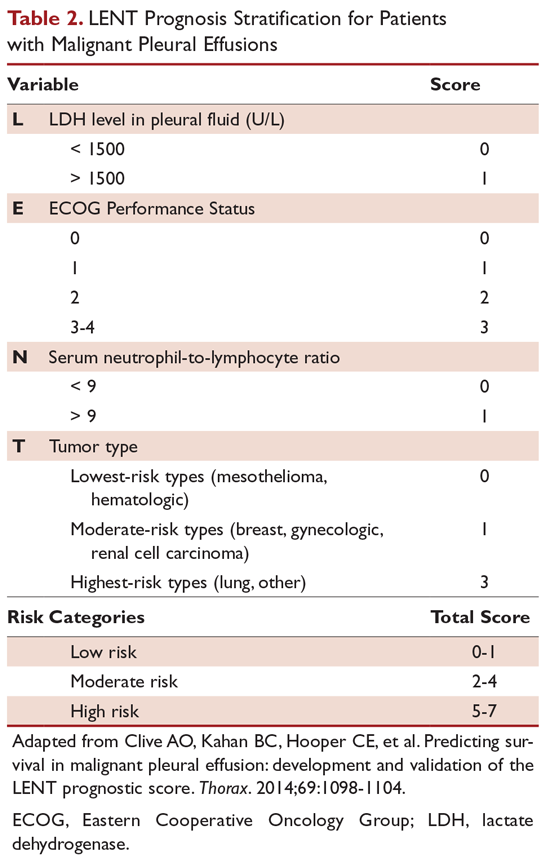what is the prognosis for malignant pleural effusion
This can cause you to feel short of breath andor have chest discomfort. MPE is an aggressive disease with a uniformly fatal prognosis and a life expectancy of only 3 to 12 months.

Prognostic Impact Of Malignant Pleural Effusion At Presentation In Patients With Metastatic Non Small Cell Lung Cancer Journal Of Thoracic Oncology
Respiratory symptoms include breathlessness cough and chest pain.

. The main symptom is difficulty in breathing. Malignant pleural effusions are caused by cancer. The patient may have unrelated symptoms due to the disease or condition that has caused the effusionSymptoms of pleural effusion include.
The prognosis of cases where the effusion is due to carcinoma of the lung or due to cancer of the. Doctors may be abl. Geographies Covered The United States.
Malignant Pleural Effusion A Malignant Pleural Effusion Mpe Is The Build Up Of Fluid And Cancer Cells That Collects Between The Chest Wall And The Lung. TPE was confirmed in 54 patients and malignant effusion in 67 patients. Malignant Pleural Effusion A malignant pleural effusion MPE is the build up of fluid and cancer cells that collects between the chest wall and the lung.
Dyspnea is the most common symptom of MPE. It is a fairly common complication in a number of different cancers. MPE can be a complication of any malignancy but in patients with lung cancer the frequency of MPE ranges from 7 to 23 1 MPE is characteristic of advanced malignancies but it may also appear in patients with a longer projected survival eg those with lymphomas including Hodgkins disease and breast carcinoma.
It represents disseminated disease and confers a poor prognosis. If due to heart failure cirrhosis or malignancy the effusion is likely to recur. Ad Pleural effusion occurs when the lining around the lungs fills with fluid and becomes.
A pleural effusion is a buildup of fluid in the area between the pleura layers of tissue that line the lungs and the chest cavity the pleural space. This condition is associated with very high mortality with life expectancy ranging from 3 to 12 months. Shortness of breath Dry cough Pain Feeling of chest heaviness or tightness Inability to lie flat Inability to exercise Generally feeling unwell Diagnosing pleural effusion.
Most common causes of malignant pleural effusion are lung cancer breast cancer lymphoma and cancer of unknown primary. People with a pleural effusion may experience the following symptoms. A complication in many types of tumors its presence indicates the onset of the terminal stages of cancer.
Development of a malignant pleural effusion is associated with a very poor prognosis with median survival of 4 months and mean survival of less than 1 year. Malignant pleural effusion MPE is a common and important clinical condition. Dyspnea is the most common symptom of.
Am J Respir Crit Care Med Vol. DelveInsights Malignant Pleural Effusion - Epidemiology Forecast to 2032 report delivers an in-depth understanding of the disease historical and forecasted Malignant Pleural Effusion epidemiology in the 7MM ie the United States EU5 Germany Spain Italy France and the United Kingdom and Japan. Malignant pleural effusion MPE is a common clinical problem that results in disabling breathlessness for patients with advanced malignancy.
Symptomatic malignant pleural effusion is a common clinical problem. Malignancy was diagnosed by either cytology or biopsy. As the pleural effusion grows it compresses the underlying lungs and.
If the underlying condition is a virus it will need to run its course. Malignant pleural effusions MPE are a common terminal pathway for many cancers with an estimated United States incidence of more than 150000 cases per year. Common symptoms include dyspnea on exertion shortness of breath and cough.
The severity of these symptoms is often affected by your position so that you may feel worse at certain positions. Patients with malignant pleural effusions have a poor prognosis and pleural effusion is considered metastatic disease. What are the symptoms of a malignant pleural effusion.
Malignant pleural effusion causes uncomfortable symptoms like progressive shortness of breath and cough. Criteria used for TPE diagnosis were positive cultures of effusion or biopsy specimen tuberculous granulomas or positive sputum cultures without other explanation for pleural effusion. Studies are contributing evidence on an increasing number of therapeutic options therapeutic thoracentesis thoracoscopic ple.
The average malignant pleural effusion life expectancy is a little less than six months with the median survival time being as less as four months. Chest pain Dry nonproductive cough Dyspnea shortness of breath or difficult labored breathing Orthopnea the inability to breathe easily unless the person is sitting up straight or standing erect. The study included 121 patients.
18 19 The most common associated. This may only be noticeable when a person exercises at first but this could get more noticeable as the amount of fluid gets worse.
Malignant Pleural Effusion Still A Long Way To Go Researcher An App For Academics

Survival Of Lung Adenocarcinoma Patients With Malignant Pleural Effusion European Respiratory Society

Malignant Pleural Effusion 03102017 Youtube

Overall Survival Probability According To Malignant Pleural Effusion Download Scientific Diagram

Mortality Among Patients With Pleural Effusion Undergoing Thoracentesis European Respiratory Society

Treatment Options For Malignant Pleural Effusions Download Table

Malignant Pleural Effusion Evaluation And Diagnosis Pulmonary Health Hub

Malignant Pleural Effusion Management Keeping The Flood Gates Shut The Lancet Respiratory Medicine

Prognostic Factors For Survival After Surgical Palliation Of Malignant Pleural Effusion Journal Of Thoracic Oncology